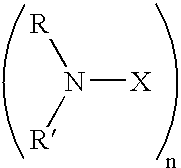Shale hydration inhibition agent and method of use
a technology of gumbo shale and inhibition agent, which is applied in the direction of sealing/packing, chemistry apparatus and processes, and wellbore/well accessories, etc., can solve the problems of increasing drilling time and cost, increasing overall volume, and gumbo shale is notorious for swelling, so as to increase the stability of the wellbore and stabilize the wellbore
- Summary
- Abstract
- Description
- Claims
- Application Information
AI Technical Summary
Benefits of technology
Problems solved by technology
Method used
Image
Examples
example 1
[0058] The following drilling muds are formulated to illustrate the claimed subject matter
Base Mud12Fresh Water276276276Duovis1.01.01.0Unitrol3.03.03.0UltraCap2.02.02.04,4′-diaminodicyclohexylmethane—10.5—Cyclohexylamine——10.5Barite201201201pH Adjusted (Acetic Acid)9.49.49.4
[0059] In the above mud formulation the following commercially available compounds have been used in the formulation of the well bore fluid, but one of skill in the art should appreciate that other similar compounds may be used instead.
UltraCapM-I SWACO, Houston TXUltraFreeM-I SWACO, Houston TXUnitrolM-I SWACO, Houston TXDuo VisKelco Oil Field Group
[0060] The properties of the above muds as well as a base mud (i.e. a mud in which there is no shale hydration inhibition agent) are measured and give the following exemplary data:
PropertiesViscosity (cps) at AmbientTemperatureBase Mud12600 rpm136115109300 rpm1018476200 rpm857463100 rpm584843 6 rpm161312 3 rpm111010Gels 10 sec.12121210 min.161413PV353133YP665343A...
example 2
[0065] The following testing was conducted to demonstrate the maximum amount of API bentonite that can be inhibited by a single 10.5 ppb treatment of shale hydration inhibition agents of the claimed subject matter over a period of days. This test procedure uses pint jars that are filed with one barrel equivalent of tap water and 10.5 ppb of a shale hydration inhibition agent. Tap water was used as a control sample. All samples were adjusted to at least a pH of 9.5 with hydrochloric acid and treated with a 10 ppb portion of M-I GEL (API bentonite) at a medium sheer rate. After stirring for 30 minutes, the samples were heat aged overnight at 150 □F. After the samples were cooled, their rhelologies were recorded at ambient temperature. This procedure was carried out for each sample until all were too thick to measure. The tables below present representative data that shows the shale hydration inhibition effect of the claimed subject matters by the daily addition of bentonite in tap wat...
example 3
[0073] In this example, 3% by weight of 4,4′-dimethyldicyclohexylmethane was dissolved into 1.5% glacial acetic acid solution in distilled water. A clear solution formed upon stirring the mixture. To this resulting solution a sufficient amount of 1.0 N sodium hydroxide was added to bring the pH to about 10.5. A white precipitate formed at this pH. The precipitate could be redissolved upon adjusting the pH to about 9.5.
[0074] The above example illustrates that a preferred shale hydration inhibition agent of the present disclosure can be precipitated out of solution and onto shale surfaces by adjusting the pH. One of skill in the art should appreciate that the ability to form this precipitate will prompt the formation of a membrane that should enhance well stability.
PUM
| Property | Measurement | Unit |
|---|---|---|
| pH | aaaaa | aaaaa |
| temperature | aaaaa | aaaaa |
| swelling | aaaaa | aaaaa |
Abstract
Description
Claims
Application Information
 Login to View More
Login to View More - R&D
- Intellectual Property
- Life Sciences
- Materials
- Tech Scout
- Unparalleled Data Quality
- Higher Quality Content
- 60% Fewer Hallucinations
Browse by: Latest US Patents, China's latest patents, Technical Efficacy Thesaurus, Application Domain, Technology Topic, Popular Technical Reports.
© 2025 PatSnap. All rights reserved.Legal|Privacy policy|Modern Slavery Act Transparency Statement|Sitemap|About US| Contact US: help@patsnap.com



